Picture this: you’re scrolling through your favourite online store, have a quick question about a product, and instantly get a helpful response from a chat window.
Or maybe you’re cooking dinner and need a recipe suggestion, and your smart speaker chimes in with a perfect match. Welcome to the world of conversational agents!
These AI-driven marvels are revolutionising how we interact with technology, making our lives smoother and more connected.
In this blog, we’ll break down what conversational agents are, showcase their amazing benefits, and share some standout examples.
Ready to discover how these digital assistants are changing the game? Let’s get started!
Understanding Conversational Agents – A Quick Overview
A conversational agent, also known as a chatbot, is a dialogue system responsible for human-computer interaction. As evident by its name, chatbots are robots that chat with humans.
One thing about chatbots is that they are not standalone applications that you can simply install on your mobile device or PC and begin using. These conversational AI-based agents are integrated into different websites and messaging applications.
The conversational agents or chatbots are not exclusive to tech-savvy people and are accessible to people of all ages and backgrounds. Conversational agents have applications in various sectors, including entertainment, customer support, education, etc.
Insider Hack: Know more about AI chatbots in this ultimate guide!
How Does a Conversational Agent Work?
Now that you have a brief overview of conversational agents let us explain how they work. We will explore the technology behind these agents, their components, and the different types of conversational agents available.
Technology Behind Conversational Agents
Here is a breakdown of the technology responsible for the working of conversational agents.
Natural Language Processing (NLP): NLP comes first and helps the agent interpret human language. This technology, simply put, assists the agent in decoding the input; if it’s speech, NLP converts it into text for easy interpretation.
Machine Learning (ML): Machine learning forms the core/backbone of such conversational agents. This technology allows the agent to learn from human interactions and improve over time.
Artificial Intelligence (AI): Artificial intelligence is responsible for generating responses. It plays a significant role in helping the agent make decisions and sharpens its problem-solving capabilities.
What Are the Components of a Conversational Agent?
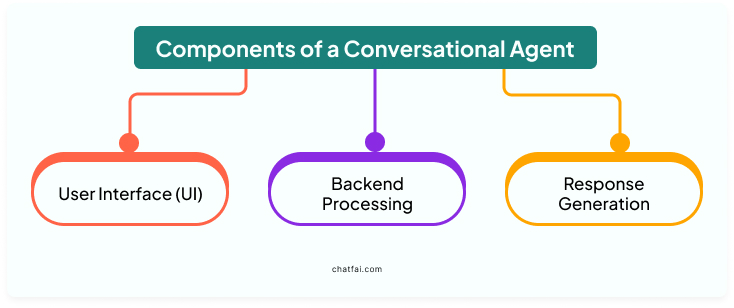
If you hear about a conversational agent, you might wonder how it is made or what its components are. Well, we have your back. Below, we have listed the main components of making a conversational agent.
User Interface (UI): The user interface is the platform or window where user and agent interact.
Backend Processing: The backend processing, i.e., the entire behind-the-scenes system of the agent, is responsible for input processing and response generation.
Response Generation: Lastly, there is response generation, which involves the generation of responses or replies based on the context or intent of the input.
Types of Conversational Agents
Conversational agents are of different types based on the communication method.
Text-based: As the name suggests, these agents use written messages or texts for interactions. AI chatbots are a common example of text-based conversational agents.
Voice-based: The conversational agents using spoken language or voice to communicate or interact come under this category. Siri and Alexa are some common examples.
Multimodal: Multimodal conversational agents come next, using various inputs or communication methods, including text, voice, and others, such as touch displays.
Benefits of Using Conversational Agents
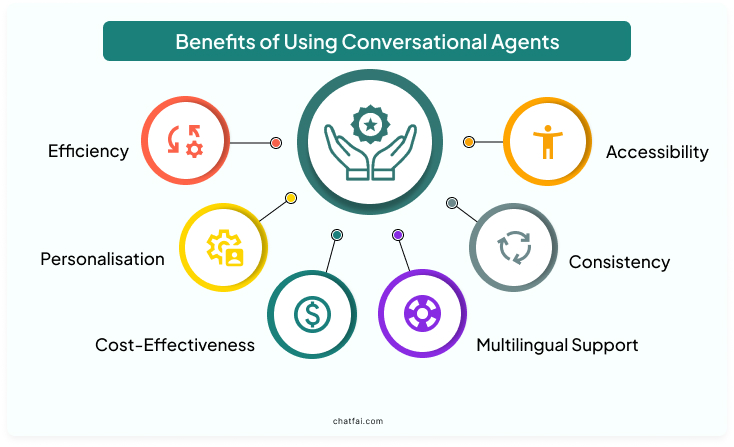
To understand conversational agents better and establish an opinion on why you should rely on them, it’s crucial to have a detailed look at their benefits.
Though numerous benefits are associated with using conversational agents, we have listed a few of the top ones here.
Pro Tip: See how chatbots efficiently improve customer experience in this guide.
1. Efficiency
One of the biggest advantages of conversational agents is their efficiency. These agents can handle multiple queries at a time, which won’t affect their performance.
2. Cost-Effectiveness
These agents are responsible for automating routine operations and cutting custom service costs. This allows businesses to invest resources in more complex operations requiring human intervention.
3. Personalisation
Another benefit of using conversational agents for handling customer queries is the personalisation they offer. These agents remember past interactions and user preferences, generating responses tailored to their needs.
4. Accessibility
AI-based agents are available 24/7, providing users instant replies and solving their problems in real time. For instance, voice-based agents can help visually impaired users navigate various interfaces whenever needed.
Tip: AI chatbots for fun is a wide aspect of conversational agents. Learn more about the fun aspect in this guide!
5. Consistency
As mentioned above, regardless of the number of queries and users they are catering to or their 24/7 availability, you won’t notice even a slight decrease in conversational agents’ performance. This consistency helps maintain a reliable brand image.
6. Multilingual Support
Many of these conversational agents are responsible for providing support in multiple languages, making them accessible to wider audiences.
7. Reduced Human Error
As the responses generated by conversational agents are automated, this significantly reduces the risk of human error. These agents also stick to guidelines and programmed protocols, ensuring reliable communication.
Pro Tip: Curious to know more about the benefits of AI chatbots for businesses? This guide has you covered!
Examples of Conversational Agents
Some common examples of conversational agents are voice-based assistants like Siri and Alexa, Google Assistant and AI chatbots like ChatGPT, ChatFAI, etc.
Below, we have provided a breakdown of ChatFAI, an AI chatbot that allows you to chat with your favourite characters from movies, TV shows, books, history, and more.
ChatFAI – AI Chatbot for Virtual Interactions
ChatFAI is an AI-powered AI chatbot that you can use to chat with your favourite characters, be it from movies, cartoons, fictional books, or any other world you are intrigued by.
This AI chatbot lets you establish a personal connection with the virtual chatbots, keeping your chats secure. You can even decide these chatbots’ appearance, personality traits, and public description to fit your preferences.
Key Features of ChatFAI
Here is a glimpse of some key features of ChatFAI.
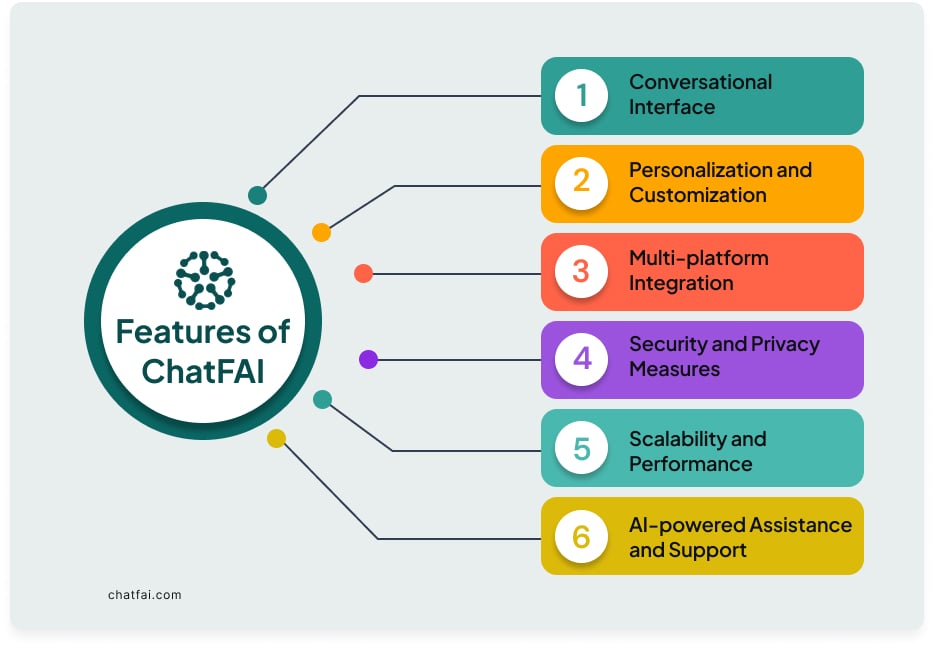
How to Create an AI Character Using ChatFAI?
Here are the steps you need to follow to create an AI character using ChatFAI.
Step 1
Visit the official website of ChatFAI.
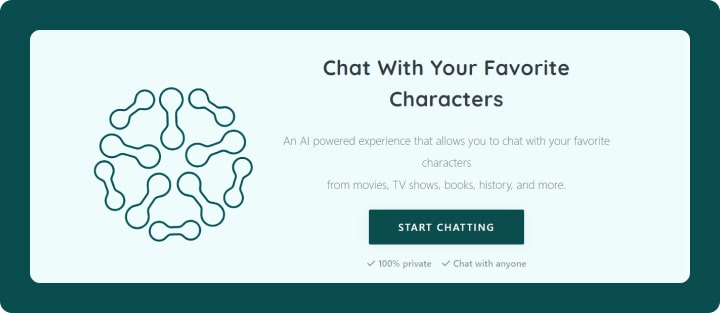
Step 2
Select the “New Character” option on the left pane.
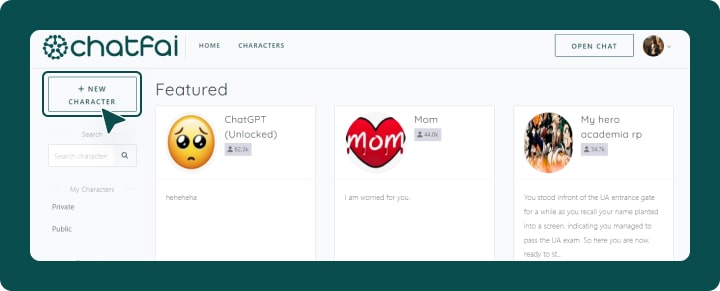
Step 3
Fill in the required details, such as your character’s Name, Nickname, Description, Bio, and profile picture. In this case, add the traits of your favourite one-piece character.
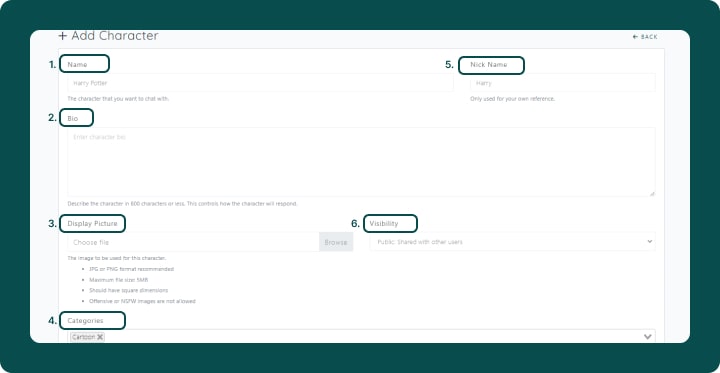
Step 4
Choose the “Add Character” option at the bottom, and your new AI character will be on board.
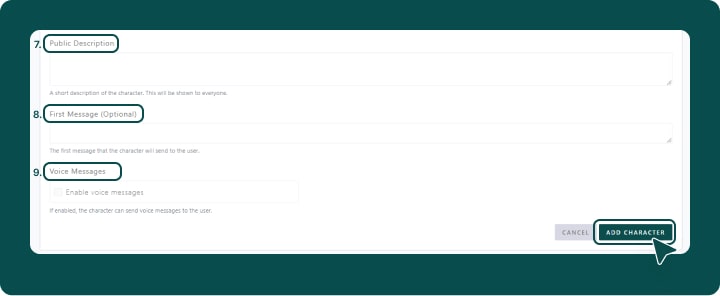
Step 5
Once the character is created, select “Start Chat” to start conversing with it.

Tip: Know more about how to generate and talk to AI characters using ChatFAI in this guide.
Pricing Plans
The pricing plans of ChatFAI are as follows:
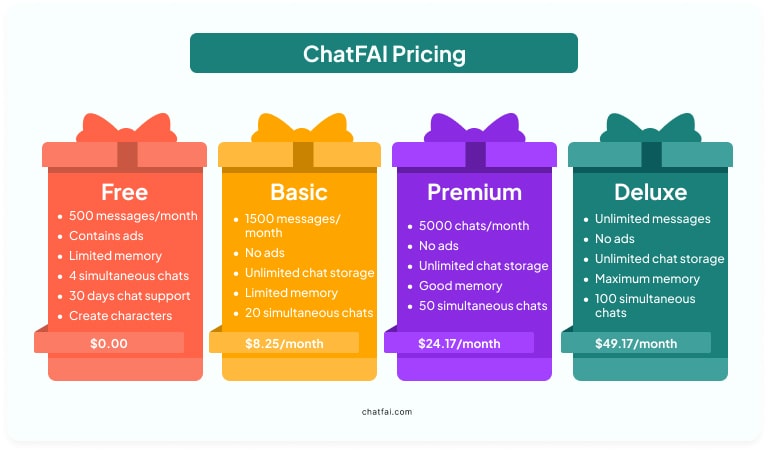
Pro Tip: Check out this guide for a detailed overview of ChatFAI, its features, filters and more.
Concluding Remarks
As we’ve seen, conversational agents are more than just tech buzzwords—they transform how we interact with the digital world.
These AI-powered assistants are here to stay, from boosting efficiency and cutting costs to offering personalised, round-the-clock assistance.
As technology advances, who knows what amazing things they’ll do next? So, watch for these digital sidekicks—they’re already making a big splash, and the future looks even brighter!
Not sure which chatbot to start with? ChatFAI can be a safe pick for you.
Hurry up before it’s too late!
Keep smiling!
FAQs
Q: What Is the Difference Between a Chatbot and a Conversational Agent?
A chatbot sticks to predefined answers based on the information already fed into it. Conversational AI, on the other hand, offers a more advanced approach, allowing it to interpret user input and come up with appropriate and custom responses.
Q: What Is a Conversational Agent in NLP?
Conversational agents, or chatbots, communicate with users using written or spoken natural language. These agents accept different inputs like speech, text, or video.